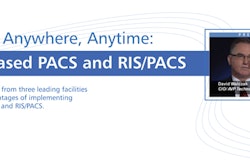Following the Bush administration's directive for creating a national electronic medical record (EMR) network, the U.S. Department of Defense has initiated a similar effort to have an EMR system in place by 2011 in its Military Health System (MHS). The new military EMR will involve the wide-scale deployment of voice recognition software across all military treatment facilities.
Called AHLTA (Armed Forces Health Longitudinal Technology Application), the new system is designed to be an interoperable, globally accessible, secure EMR for active military, retirees, and their families. The Department of Defense has shifted to a voice-to-text configuration for data input to address shortcomings experienced with the keyboard-based methods that were used previously.
The Department of Defense launched AHLTA two years ago, in part, using a structured text format that prompted users to electronically check "Yes" or "No" boxes to complete a patient's medical information. The process proved to be a bottleneck for documentation.
"It was fairly labor intensive and it produced a non-narrative note," said Dr. Robert Bell Walker, Europe Regional Medical Command AHLTA consultant. "It was taking an inordinate amount of our time away from home or patient care."
Voice-to-text format
Eighteen months into AHLTA, MHS shifted healthcare practitioners to a voice-to-text format, which allows for applications, such as voice recognition and other keyboard data input programs, to improve data entry efficiency.
MHS chose Dragon NaturallySpeaking Medical software from speech recognition and document management firm Nuance Communications of Burlington, MA. Walker said the technology opened the electronic medical record system to voice-to-text documentation, essentially combining structured check boxes with notation capabilities.
When a physician performs a foot exam on a diabetic patient, for example, the structured section includes basic information from a previous visit and necessary follow-up, while voice recognition-generated notes provide additional perspectives. "The use of EMR and structured text improves patient care and reminds us of things we need to do," Walker said. "Then voice recognition gives us a narrative quality note that we can read and pass on to a colleague, so they know what we are doing [for the patient]."
Report turnaround
Voice recognition technology has made report turnaround time almost instantaneous in some cases, Walker added. When he dictates a report, it can be printed immediately. "I can dictate a discharge or transfer summary, print it off, and put it on the patient's chest as he is going down the hall to the ambulance," he said. "What you see is right before you; you aren't correcting something tomorrow."
With more typical cases, such as an appendectomy or colonoscopy, Walker only has to say a few words and the voice recognition software will print "predone" information related to the procedure. He will add relevant notes, because no two patients are alike, after saying a few words to specify the procedure. "I can say 'normal colonoscopy' and I have just done an entire procedure note and it doesn't need to be proofread," he said.
In some military facilities, voice recognition software has been added to wireless computer tablets, allowing physicians mobility from patient to patient. "The provider can walk from room to room with the tablet under his arm," Walker said. "You don't have to log on to a computer; the computer is not a barrier between you and the patient anymore."
Patient throughput
Voice recognition technology also has helped pediatrician Major Craig Rohan and his colleagues at Peterson Air Force Base in Colorado Springs, CO, where the clinic tends to approximately 30 patients per day. While voice recognition has reduced report time and allowed for enhanced patient throughput, the "main issue is the patients I see have far more thorough documentation," Rohan added. "If I am not available, my partners know what I am thinking, get what the story was, and why I had done whatever I had done."
Peterson does not have an emergency room, but the clinic does treat children with everything from open wounds and fractures to basic periodic checkups. "In many ways, it is a typical pediatrics practice with well child care and follow-up of routine medical conditions," Rohan said.
For moderate or complex cases, such as a chronic illness, that require extensive documentation of the young patient's history, the intricacy of the treatment plan benefits from voice recognition technology and the more detailed notes and perspectives it can provide.
Training personnel
Training for a military healthcare facility is critical, even beyond the adoption of voice recognition technology, because of the high personnel turnover rate. "We are in a turbulent environment," Walker said. "We have 90-day reservists coming in and others coming in for one year. Last year we had a 300-person provider turnover in one day, when the Navy came in and turned it over. That presents unique challenges to the military system to keep everybody trained. We want to balance expectations with reality. We don't want to overpromise and underdeliver."
The adoption of voice recognition was fairly easy for physicians at Peterson, with training a matter of getting accustomed to using the technology. "You have to do a microphone check and some dictation reading, but you're pretty much ready to go in about 15 minutes," Rohan said. "If you use it more and more and further refine things, even after 15 minutes, it's in the high 90s in terms of how accurate it is."
Walker sees the adoption of voice recognition increasing among military facilities around the globe, as more healthcare personnel are introduced to the technology. "If you just throw technology out there without showing them how it is useful within their EMR, then your return will be diminished," he said. "I believe that once you invest that training and show them how it is used in your program and how it can make their lives easier, it will make their lives easier."
Walker advises taking a couple of weeks or a month to get used to voice recognition technology and then assess its utility and one's comfort level with it.
Enhanced efficiency
The physicians at Peterson Air Force Base already are onboard in their support. "I can say without question that we are one of the most efficient clinics in the Department of Defense," Rohan said. "We do a lot of unique things in this clinic and voice recognition is a part of it. We are among the most efficient, seeing 30 patients per day. Most military clinics are not seeing that breadth, especially with some of certifiable quality numbers. Our measurements -- such as vaccination rates, hospitalizations, and care of chronic conditions -- do very well."
MHS expects to be in full rollout phase for voice recognition technology later this year, having acquired licenses for Dragon Medical for use throughout Europe, including the wireless tablets.
By Wayne Forrest
AuntMinnie.com staff writer
July 15, 2008
Related Reading
Speech recognition shrinks report turnaround time, May 29, 2008
Speech recognition and structured reporting bring advantages, drawbacks, May 12, 2008
Voice recognition key to fast report turnaround, April 24, 2008
Wise planning helps bring 3D lab to the community practice, February 19, 2008
White noise may improve accuracy of SR system, November 27, 2007
Copyright © 2008 AuntMinnie.com



















